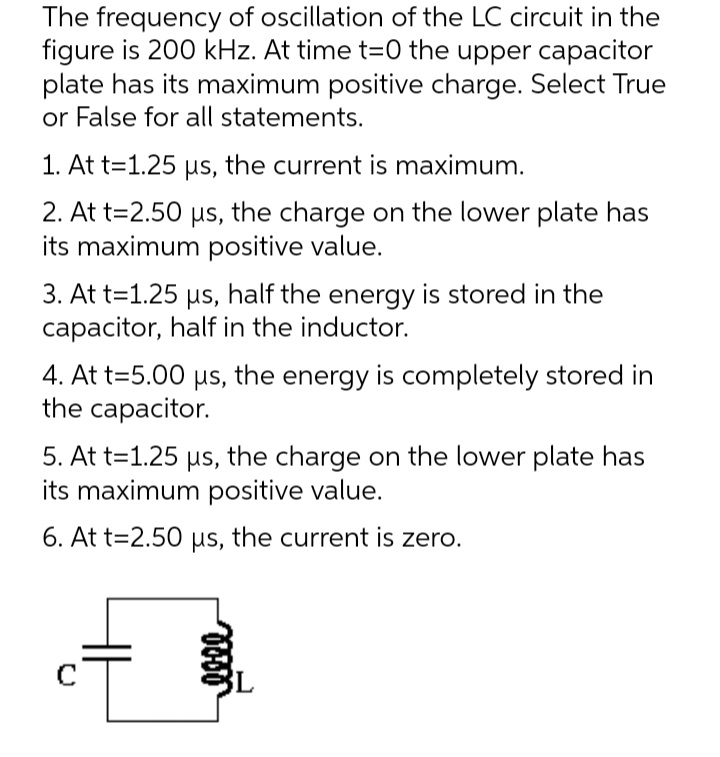The frequency of oscillation of the LC circuit in the figure is 200 kHz. At time t=0 the upper capacitor plate has its maximum positive charge. Select True or False for all statements. 1. At t=1.25 us, the current is maximum. 2. At t=2.50 us, the charge on the lower plate has its maximum positive value. 3. At t=1.25 us, half the energy is stored in the capacitor, half in the inductor. 4. At t=5.00 us, the energy is completely stored in the capacitor. 5. At t=1.25 us, the charge on the lower plate has its maximum positive value. 6. At t=2.50 us, the current is zero.
The frequency of oscillation of the LC circuit in the figure is 200 kHz. At time t=0 the upper capacitor plate has its maximum positive charge. Select True or False for all statements. 1. At t=1.25 us, the current is maximum. 2. At t=2.50 us, the charge on the lower plate has its maximum positive value. 3. At t=1.25 us, half the energy is stored in the capacitor, half in the inductor. 4. At t=5.00 us, the energy is completely stored in the capacitor. 5. At t=1.25 us, the charge on the lower plate has its maximum positive value. 6. At t=2.50 us, the current is zero.
Chapter14: Inductance
Section: Chapter Questions
Problem 65P: In an oscillating LC circuit the maximum charge on the capacitor is 2.0 × 10-6 C and the maximum...
Related questions
Question

Transcribed Image Text:The frequency of oscillation of the LC circuit in the
figure is 200 kHz. At time t=0 the upper capacitor
plate has its maximum positive charge. Select True
or False for all statements.
1. At t=1.25 us, the current is maximum.
2. At t=2.50 us, the charge on the lower plate has
its maximum positive value.
3. At t=1.25 us, half the energy is stored in the
capacitor, half in the inductor.
4. At t=5.00 us, the energy is completely stored in
the capacitor.
5. At t=1.25 us, the charge on the lower plate has
its maximum positive value.
6. At t=2.50 us, the current is zero.
Expert Solution
This question has been solved!
Explore an expertly crafted, step-by-step solution for a thorough understanding of key concepts.
Step by step
Solved in 2 steps with 2 images

Knowledge Booster
Learn more about
Need a deep-dive on the concept behind this application? Look no further. Learn more about this topic, physics and related others by exploring similar questions and additional content below.Recommended textbooks for you


Physics for Scientists and Engineers: Foundations…
Physics
ISBN:
9781133939146
Author:
Katz, Debora M.
Publisher:
Cengage Learning

Physics for Scientists and Engineers, Technology …
Physics
ISBN:
9781305116399
Author:
Raymond A. Serway, John W. Jewett
Publisher:
Cengage Learning


Physics for Scientists and Engineers: Foundations…
Physics
ISBN:
9781133939146
Author:
Katz, Debora M.
Publisher:
Cengage Learning

Physics for Scientists and Engineers, Technology …
Physics
ISBN:
9781305116399
Author:
Raymond A. Serway, John W. Jewett
Publisher:
Cengage Learning

Glencoe Physics: Principles and Problems, Student…
Physics
ISBN:
9780078807213
Author:
Paul W. Zitzewitz
Publisher:
Glencoe/McGraw-Hill

Physics for Scientists and Engineers
Physics
ISBN:
9781337553278
Author:
Raymond A. Serway, John W. Jewett
Publisher:
Cengage Learning

Physics for Scientists and Engineers with Modern …
Physics
ISBN:
9781337553292
Author:
Raymond A. Serway, John W. Jewett
Publisher:
Cengage Learning